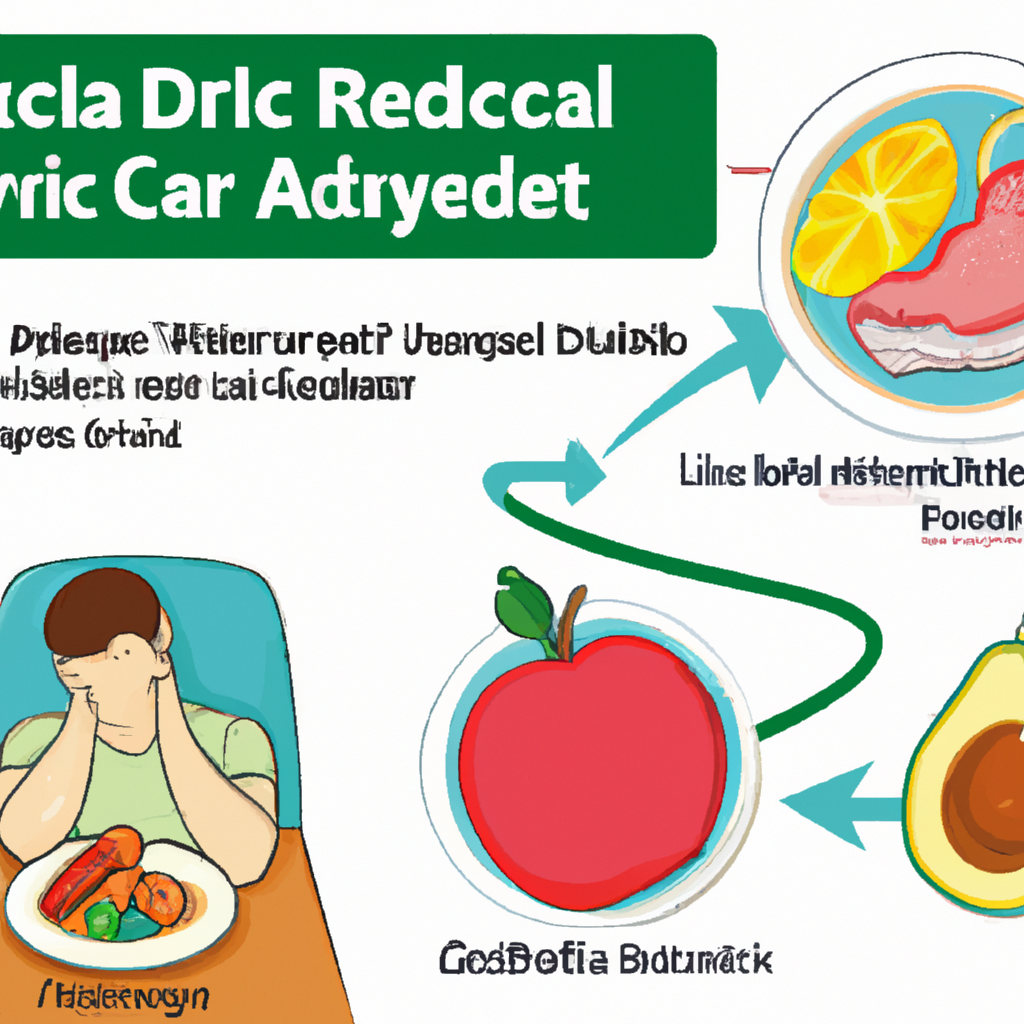If you’ve ever experienced that uncomfortable burning sensation in your chest after enjoying a spicy meal or indulging in a late-night snack, you’re no stranger to acid reflux symptoms. But did you know that your diet plays a crucial role in triggering these pesky symptoms? In this article, we will explore the fascinating connection between what you eat and the onset of acid reflux. From identifying trigger foods to making simple dietary changes, we will help you understand how to alleviate this uncomfortable condition and regain control of your digestive health. So, if you’re ready to bid farewell to heartburn and enjoy your meals without worry, let’s dive into the world of diet and acid reflux.

Overview of Acid Reflux Symptoms
Definition of acid reflux
Acid reflux, also known as gastroesophageal reflux disease (GERD), is a condition where stomach acid and other digestive juices flow back into the esophagus. The lower esophageal sphincter (LES), a muscular ring that normally prevents the backflow of stomach contents, becomes weakened or relaxed, allowing the acid to escape. This can cause discomfort, irritation, and damage to the esophagus, leading to various symptoms.
Common symptoms of acid reflux
The most common symptom of acid reflux is heartburn, which is characterized by a burning sensation in the chest or throat. Other symptoms may include regurgitation of stomach acid, chronic cough, hoarseness, difficulty swallowing, chest pain, and even unintentional weight loss. It is important to recognize these symptoms and seek proper medical advice if they persist or worsen.
Causes of Acid Reflux
Lower esophageal sphincter dysfunction
The lower esophageal sphincter (LES) plays a crucial role in preventing the backflow of stomach acid. When the LES is weak or dysfunctional, it fails to close properly, allowing acid to reflux into the esophagus. This can be caused by certain genetic factors, as well as lifestyle habits such as smoking, excessive alcohol consumption, and certain medications.
Hiatal hernia
A hiatal hernia occurs when a portion of the stomach protrudes through the diaphragm into the chest cavity. This can put extra pressure on the LES, causing it to relax and allowing acid reflux to occur. Hiatal hernias can develop due to factors such as age, obesity, and prolonged heavy lifting or straining.
Obesity
Excess weight and obesity can contribute to acid reflux symptoms. The increased pressure on the abdomen can push the stomach upward, putting pressure on the LES and leading to acid reflux. Additionally, obesity is associated with increased production of stomach acid, further exacerbating the symptoms.
Certain foods and beverages
Some foods and beverages are known to trigger or worsen acid reflux symptoms. These include spicy foods, high-fat foods, citrus fruits and juices, tomatoes and tomato-based products, chocolate, caffeinated beverages, and alcohol. When these foods are consumed, they can cause the LES to relax or stimulate excess stomach acid production, leading to an increased risk of acid reflux.
Role of Diet in Acid Reflux
Effect of food on acid production in the stomach
The foods we eat can impact the production of stomach acid. Certain foods, such as spicy foods and caffeine, can stimulate the production of excess stomach acid, increasing the likelihood of acid reflux. On the other hand, foods that are gentle on the stomach, such as whole grains and lean proteins, may help reduce acid production and alleviate symptoms.
Impact of diet on lower esophageal sphincter pressure
Diet also plays a role in the pressure of the lower esophageal sphincter (LES). Some foods, such as fatty and fried foods, can relax the LES, making it easier for stomach acid to escape into the esophagus. On the contrary, a diet rich in fiber, fruits, and vegetables may help maintain a healthy LES pressure and reduce the risk of acid reflux.
Foods that Can Trigger Acid Reflux Symptoms
Common trigger foods
Certain foods are commonly known to trigger acid reflux symptoms, including spicy foods, onions, garlic, and mint. It is important to be aware of these trigger foods and avoid or limit their consumption if you experience acid reflux.
High-fat foods
High-fat foods, such as fried foods, fatty meats, and full-fat dairy products, can relax the LES and delay digestion. This can lead to increased acid production and a higher likelihood of acid reflux symptoms. Opting for leaner cuts of meat, low-fat dairy alternatives, and healthier cooking methods can help reduce the risk of acid reflux.
Spicy foods
Spicy foods, including hot peppers, chili, and certain spices, can irritate the stomach and exacerbate acid reflux symptoms. The capsaicin found in spicy foods can trigger the release of stomach acid, leading to heartburn and discomfort. Limiting or avoiding spicy foods may be beneficial for individuals with acid reflux.
Citrus fruits and juices
Citrus fruits and their juices, such as oranges, grapefruits, lemons, and limes, are highly acidic. Consuming these acidic fruits can irritate the esophagus and trigger acid reflux symptoms in some individuals. It is recommended to opt for non-citrus fruits or consult with a healthcare professional for personalized guidance.
Tomatoes and tomato-based products
Tomatoes and tomato-based products, including ketchup, marinara sauce, and tomato juice, are also highly acidic and can contribute to acid reflux symptoms. The high acidity of these foods can irritate the esophagus and worsen the symptoms of acid reflux. Reducing or avoiding the consumption of tomatoes and tomato-based products may help alleviate acid reflux symptoms.
Chocolate
Although delicious, chocolate can be a trigger for acid reflux symptoms in some individuals. Chocolate contains a compound called theobromine, which can relax the LES and increase the risk of acid reflux. Moderating chocolate consumption or exploring alternative treats can help manage acid reflux symptoms.
Caffeinated beverages
Beverages such as coffee, tea, and soda contain caffeine, which can stimulate the production of stomach acid and relax the LES. This can lead to increased acid reflux symptoms. Choosing decaffeinated versions of these beverages or opting for less acidic alternatives, such as herbal tea or water, may be beneficial for individuals with acid reflux.
Alcohol
Alcohol, particularly in excessive amounts, can directly irritate the lining of the esophagus and increase the production of stomach acid. It can also relax the LES, making it easier for acid to escape into the esophagus. Limiting alcohol consumption or avoiding it altogether can help manage acid reflux symptoms.

Acid Reflux-Friendly Diet
Foods to include in an acid reflux-friendly diet
An acid reflux-friendly diet should include foods that are less likely to trigger symptoms and promote a healthy digestive system. Some examples of foods that are generally well-tolerated by individuals with acid reflux include bananas, melons, oatmeal, broccoli, lean proteins (like chicken and fish), whole grains, low-fat dairy products, ginger, and healthy fats (such as avocados and nuts).
Low-acid fruits
Fruits that are naturally low in acidity, such as apples, pears, and bananas, are generally well-tolerated by individuals with acid reflux. These fruits can provide important nutrients and fiber without exacerbating symptoms.
Non-citrus fruits
Non-citrus fruits, such as melons, strawberries, and grapes, are a good alternative to citrus fruits for individuals with acid reflux. These fruits are less acidic and are less likely to trigger symptoms.
Vegetables
Most vegetables are low in acid and can be a great addition to an acid reflux-friendly diet. Examples include broccoli, carrots, cauliflower, green beans, and leafy greens. These vegetables are nutritious and provide important vitamins and minerals without causing discomfort.
Whole grains
Whole grains, such as oatmeal, whole wheat bread, and brown rice, are generally well-tolerated and can provide fiber and nutrients without exacerbating acid reflux symptoms. Consuming whole grains instead of refined grains can promote digestive health.
Lean proteins
Lean proteins, such as chicken, turkey, fish, and tofu, are excellent choices for individuals with acid reflux. These proteins are less likely to stimulate excess stomach acid production and can help maintain a healthy LES pressure.
Low-fat dairy products
Low-fat dairy products, such as skim milk, low-fat yogurt, and reduced-fat cheeses, can be included in an acid reflux-friendly diet. It is important to choose low-fat options, as high-fat dairy products can exacerbate symptoms. Dairy products can provide calcium and protein, which are essential for a balanced diet.
Herbs and spices
Some herbs and spices, such as ginger, turmeric, and fennel, have been traditionally used to soothe digestive discomfort and may help alleviate acid reflux symptoms. These herbs and spices can be incorporated into meals or consumed as herbal teas.
Healthy fats
Healthy fats, such as those found in avocados, nuts, and olive oil, can be included in an acid reflux-friendly diet. These fats are less likely to trigger symptoms and can provide important nutrients and satiety.
Modifying Eating Habits for Acid Reflux
Eat smaller meals
Consuming smaller meals throughout the day instead of large meals can help prevent the overproduction of stomach acid and reduce the risk of acid reflux. Eating smaller portions allows the stomach to digest food more efficiently and can alleviate symptoms.
Avoid eating close to bedtime
Eating a large meal or consuming trigger foods close to bedtime can increase the likelihood of acid reflux symptoms during the night. It is recommended to finish eating at least two to three hours before lying down to allow the stomach to empty and reduce the risk of reflux.
Don’t lie down right after eating
Lying down immediately after a meal can promote the backflow of stomach acid into the esophagus. It is advisable to remain upright and engage in light activities, such as taking a short walk, before reclining or going to bed.
Elevate the head of the bed
Raising the head of the bed by using pillows or a bed wedge can help prevent acid reflux during sleep. By elevating the upper body, gravity can assist in keeping stomach acid from flowing back into the esophagus.
Slow down while eating
Eating slowly and chewing food thoroughly can aid digestion and prevent overeating. Rushing through meals can lead to excessive amounts of air being swallowed, which can contribute to acid reflux symptoms. Taking the time to savor each bite can also help individuals recognize when they are full, preventing overeating and possible discomfort.
Stay upright for a few hours after meals
Remaining upright for at least two to three hours after eating can help prevent acid reflux symptoms. This allows sufficient time for the stomach to empty and reduces the pressure on the LES, reducing the likelihood of acid reflux.
Other Lifestyle Changes to Manage Acid Reflux
Maintain a healthy weight
Maintaining a healthy weight is important for overall health and can also help manage acid reflux symptoms. Excess weight, especially around the abdomen, can put pressure on the stomach and LES, increasing the risk of acid reflux. Incorporating regular exercise and following a balanced diet can aid in weight management and improve symptoms.
Quit smoking
Smoking can aggravate acid reflux symptoms in several ways. It weakens the LES, impairs the digestive process, and increases stomach acid production. Quitting smoking can improve overall health and reduce the frequency and severity of acid reflux symptoms.
Manage stress levels
Stress can worsen acid reflux symptoms and contribute to gastrointestinal sensitivities. Finding healthy ways to manage stress, such as through exercise, mindfulness, or engaging in hobbies, can help alleviate symptoms and promote overall well-being.
Avoid tight-fitting clothes
Wearing tight-fitting clothes, particularly around the abdomen, can put pressure on the stomach and LES, triggering or worsening acid reflux symptoms. Opting for looser clothing can help alleviate discomfort and reduce the risk of acid reflux.
Avoid certain medications
Some medications, such as nonsteroidal anti-inflammatory drugs (NSAIDs), certain pain relievers, and certain muscle relaxants, can contribute to acid reflux symptoms. It is important to discuss medication use with a healthcare professional and explore alternative options if necessary.
The Role of Acid Reflux Triggers in Individual Cases
Identifying personal trigger foods
Each individual may have unique trigger foods that worsen their acid reflux symptoms. Keeping a close eye on symptoms and noting which foods or beverages consistently cause discomfort can help identify personal trigger foods. Avoiding or limiting the consumption of these trigger foods can greatly improve symptoms.
Keeping a food diary
Maintaining a food diary can be a helpful tool in identifying patterns between diet and acid reflux symptoms. Recording meals, snacks, and symptoms can provide valuable insights into which foods and beverages may be triggering acid reflux. This information can then be used to make more informed dietary choices.
Working with a healthcare professional
If acid reflux symptoms persist or significantly impact daily life, it is important to seek medical advice. A healthcare professional, such as a gastroenterologist or registered dietitian, can provide personalized guidance and recommendations based on individual needs. They can help identify triggers, offer dietary modifications, and suggest other treatments options if necessary.
When to Seek Medical Advice
Persistent or severe acid reflux symptoms
If acid reflux symptoms persist despite lifestyle modifications and over-the-counter remedies, seeking medical advice is recommended. Persistent or severe symptoms may require further evaluation and treatment to manage the underlying cause of acid reflux.
Difficulty swallowing
Difficulty swallowing, also known as dysphagia, can be a symptom of a more serious condition and should be evaluated by a healthcare professional. It is important to determine the underlying cause of the swallowing difficulty and receive appropriate treatment.
Unintentional weight loss
Unintentional weight loss can be a concerning symptom that warrants medical attention. If acid reflux symptoms are accompanied by significant weight loss, it may indicate an underlying issue that requires evaluation and treatment.
Chest pain
Chest pain can be a symptom of acid reflux or a more serious condition, such as heart disease. If chest pain is severe, persistent, or accompanied by other concerning symptoms, it is essential to seek immediate medical attention.
Chronic cough or hoarseness
A chronic cough or hoarseness that persists for an extended period of time may be indicative of acid reflux. Consulting a healthcare professional can help determine the underlying cause and provide appropriate treatment.
Conclusion
Understanding the link between diet and acid reflux symptoms is crucial for managing this condition effectively. By making informed dietary choices, avoiding trigger foods, and implementing lifestyle modifications, individuals can reduce the frequency and severity of acid reflux symptoms. It is important to remember that everyone is different, and what works for one person may not work for another, so personalized guidance from a healthcare professional should be sought for optimal management of acid reflux. With the right approach, individuals with acid reflux can lead a comfortable and fulfilling life.
